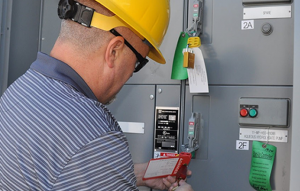 Print a Sign-In Sheet | Spanish Version
Print a Sign-In Sheet | Spanish Version
The Occupational Safety and Health Administration (OSHA) Standard for The Control of Hazardous Energy (Lockout/Tagout), 29 CFR 1910.147, addresses the practices and procedures necessary to disable machinery or equipment, thereby preventing the release of hazardous energy while employees perform maintenance activities. The standard outlines measures for controlling hazardous energies, such as electrical, mechanical, hydraulic, pneumatic, chemical, thermal, and other energy sources.
Definitions
Lockout – The placement of a lockout device on an energy-isolating device, in accordance with an established procedure, ensuring that the energy-isolating device and the equipment being controlled cannot be operated until the lockout device is removed.
Tagout – The placement of a tagout device on an energy-isolating device, in accordance with an established procedure, to indicate that the energy-isolating device and the equipment being controlled may not be operated until the tagout device is removed. The tagout device should only be used to warn workers when equipment cannot be locked out.
Affected employee – An employee whose job requires him/her to operate or use a machine or equipment on which service or maintenance is being performed under lockout or tagout or whose job requires him/her to work in an area in which service or maintenance is being performed.
Authorized employee – A person who locks out or tags out machines/equipment in order to perform service or maintenance on that piece of equipment; an affected employee becomes an authorized employee when that employee’s duties include performing service or maintenance.
Forms of Hazardous Energy
Kinetic Energy (Mechanical) – Moving parts of mechanical systems.
Potential Energy – Stored energy sometimes found in pressure vessels, gas tanks, hydraulic and pneumatic systems, and springs; potential energy can be released and become mechanical energy (e.g., gravity).
Electrical Energy – Generated energy from electrical power, static sources, or electrical storage devices.
Thermal Energy – Energy resulting from mechanical work, radiation, chemical reaction, or electrical resistance.
Things to Remember
- Never remove a lock without authorization.
- Never turn on a machine during lockout.
- Never operate a machine that has been tagged.
- Stay clear of locked or tagged machinery until you are notified that the power is back on.
- Before removing lock and tag, make sure all guards are back in place and all tools are removed from the machinery.
KEMI does not assume liability for the content of information contained herein. Safety and health remain your responsibility. This information is to be used for informational purposes only and not intended to be exhaustive or a substitute for proper training, supervision, or manufacturers’ instructions/recommendations. KEMI, by publication of this information, does not assume liability for damage or injury arising from reliance upon it. Compliance with this information is not a guarantee or warranty that you will be in conformity with any laws or regulations nor does it ensure the absolute safety of any person, place, or object, including, but not limited to, you, your occupation, employees, customers, or place of business.

